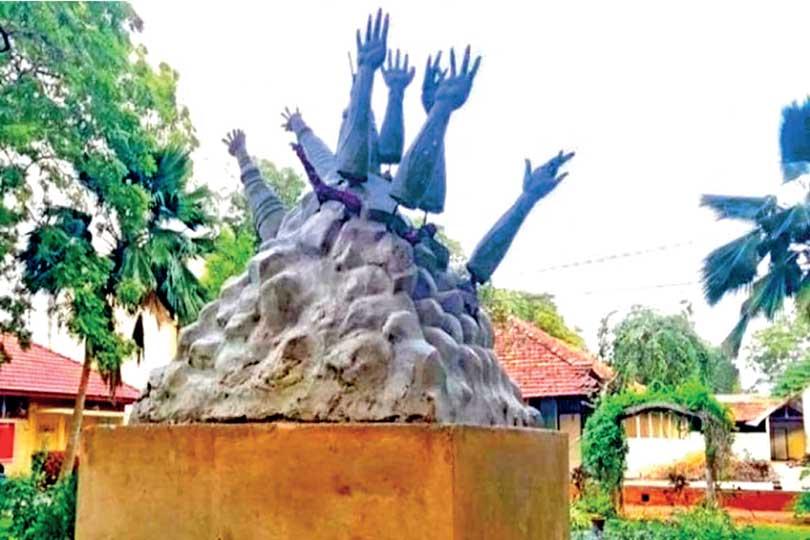12 Jan 2021 - {{hitsCtrl.values.hits}}

Tamil war memorial monument in
Jaffna university compound before demolition
 ‘If only they would respect Tamils as humans’
‘If only they would respect Tamils as humans’
An alleged former combatant who was ‘rehabilitated’
The Liberation Tigers of Tamil Eelam (LTTE), is the armed group that the Mahinda Rajapaksa and Gotabaya Rajapaksa government claim they defeated in May 2009. During the first Rajapaksa regime and after the Rajapaksas returned to power in 2019, even in the midst of the pandemic, their government has held annual events to celebrate its victory over the LTTE, which it always proudly states it destroyed. At the same time, even in 2021, 11 years after the end of the armed conflict, it is the Rajapaksa regime that has kept the LTTE very much alive in public discourse. It appears unwilling or unable to let the LTTE go, perhaps because it needs to revive the spectre of the LTTE to remind people of its greatness, and reiterate that only the Rajapaksas can protect the people and the country.
Paradoxically, while preventing Tamils from commemorating the war dead, the government does a good job of ensuring the public and the Tamil people do not forget the LTTE. As I have written elsewhere, many former cadres have said that at government rehabilitation centres that they were instructed to forget the past. Yet, constant interrogation by the Sri Lanka Army (SLA) and surveillance and monitoring of ex-cadres forced them to remember their past. Some cadres said ‘they asked us to forget the past but… they continue to ask us about our time in the LTTE’
It is the Rajapaksa government that has erected monuments that conjure images of war, violence and celebrate militarism, in the form of statues of soldiers, guns, armoured tanks and bullets that one sees dotted all over the North
Since the genesis of the LTTE, it has been quite common for both the state and even the Sinhalese public to equate Tamils with the LTTE. I say this from my personal experience, as well as that of my parents, friends and acquaintances, who have encountered this numerous occasions. Persons are labelled as LTTE or a LTTE supporter/sympathizer because at the minimum, it creates suspicion about the person socially and opens the person to vilification, and at worst it places the person at risk of arrest and detention, often on negligible or no evidence, or worse. Hence, labelling someone LTTE is a tool used to control social action and dissent.
While labelling Tamil people LTTE, the two Rajapaksa regimes have had no qualms including LTTE senior cadres who are alleged to have committed serious human rights violations, including war crimes, such as Karuna and Pillyan, in their governments. The Rajapaksa regimes justify this on the basis that Karuna and Pillayan helped them win the war. Does that make the human rights violations which they allegedly committed, about which Karuna even boasted during the general election campaign in 2020, ‘disappear’ (pun intended)? The lesson here is that violations by the victor do not matter. Nor do human rights violations matter if you are aligned with the victor. The victory is the sanitizer that washes away human rights violations.
The title of an article published on the ITN website on January 9, 2021 about the protest against the demolition on January 8, 2021 of the memorial at Jaffna University dedicated to the war dead says, “Students who were going to be terrorists kneel before the STF’. This illustrates the way in which the process of labelling Tamil youth LTTE is used to curb dissent. It also demonstrates the power-high the government and its affiliates seem to acquire from portraying the protest not as Tamil youth challenging repression, i.e. as a challenge to their power, but as the military subjugating the youth, i.e. putting the Tamil youth in their place. Two elements that cannot be missed in this headline are: The lack of respect for Tamils as equal citizens and the intent of disempowering them.
Following the uproar after the demolition of the Jaffna University memorial, the Chairman of the University Grants Commission (UGC) released a letter and video on January 9, 2021 justifying the demolition. With no sense of irony, the Chairman makes the counter-factual statement that one of the reasons for the demolition is the fact that it is a memorial related to war, which would be a hindrance to North-South unity and therefore unsuitable for the present and the future. His statement is factually incorrect for two reasons. Firstly, it is the Rajapaksa government that has erected monuments that conjure images of war, violence and celebrate militarism, in the form of statues of soldiers, guns, armoured tanks and bullets that one sees dotted all over the North. Secondly, contrary to the Chairman’s statement, the memorial at Jaffna University is one with outstretched hands rising from the earth. While such willful ignorance, or if one chooses the generous interpretation, the lack of awareness of the Chairman of the UGC is shocking, it is not entirely surprising. The Chairman’s attitude merely reflects the belief of the government and even sections of the Southern public that the conflict was not an ethnic conflict but a terrorist issue, which was resolved when the LTTE was defeated. Hence, in their minds there is nothing left to resolve, nor a need to remember.
The facts that no-one, not even the Rajapaksa government, can wish away are the following. There was an armed conflict in Sri Lanka for nearly 30 years, which was preceded by decades of ethnic strife. The root causes of the ethnic conflict are discrimination, marginalization and violence, which are yet to be adequately addressed. Racism, prejudice and bigotry are deeply rooted in Sri Lanka, and that too is not being addressed but has historically been fanned to suit ethno-nationalist agendas. And no, saying this does not make me LTTE or a racist. And yes, I am aware and acknowledge that prejudice and bigotry exist within the Tamil and Muslim communities too. And yes, the LTTE too committed grave human rights violations. But let’s not distract ourselves from discussing the responsibilities of the government to its people, and how government action and inaction shape and exacerbate social prejudice and cause violence.
While labelling Tamil people LTTE, the two Rajapaksa regimes have had no qualms including LTTE senior cadres who are alleged to have committed serious human rights violations, including war crimes, such as Karuna and Pillyan, in their governments
What the government refuses to accept is that there is no triumph in war. There is nothing to celebrate in the death of one’s citizens, of whichever ethnicity they may be. There is nothing to rejoice in the destruction of property and belongings of one’s citizens, of whichever ethnicity they may be. By denying that the war was painful, the government defies the public to even feel grief, let alone express it. Even families of the Sri Lankan armed forces are expected to show only pride in and happiness about the achievements of their departed family members; they too are expected not to express their loss, loneliness and grief.
To ensure non-recurrence, as desired by the Chairman, UGC, we have to deal with the past because it lives in the present and will only grow in the future. Like in an addiction treatment programme, to deal with the root causes of the conflict, we must first acknowledge the problem that exists. To deny the problem and force forgetting only builds a façade of peace with discontent bubbling beneath. We Sri Lankans are addicted to denial and delusion, and must wean ourselves off denial and delusion, if we are to achieve meaningful peace.
There is nothing to rejoice in the destruction of property and belongings of one’s citizens, of whichever ethnicity they may be. By denying that the war was painful, the government defies the public to even feel grief, let alone express it
30 Nov 2024 1 hours ago
30 Nov 2024 2 hours ago
29 Nov 2024 29 Nov 2024
29 Nov 2024 29 Nov 2024
29 Nov 2024 29 Nov 2024